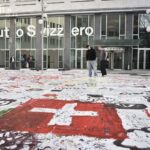The Basler Fasnacht (19-21 September) is history again. But what a magical, emotional and at the same time familiar moment it was again on Monday morning at 04.00 on the Martinsplatz (and other places in the city centre).
The weeks and days preceding Fasnacht, Vorfasnacht, were already dominated by this moment. Various performances in theatres, schools, cafes, restaurants and other establishments and organisations were the warming-up.
However, many months before, active participants, the Fasnächtler and Fasnächtlerinnen and their formations, associations and Cliques, were already busy with the creative, musical and organisational preparations. All the honour of being recognised as a UNESCO World Heritage Site belongs to them.
Only to them, no, the hundreds of thousands of visitors, the Fasnacht committee (das Fasnachts-Comité), other Fasnacht associations, the city administration and numerous volunteers also make this grandiose event a (centuries-old) phenomenon.
Or, in the words of the editor-in-chief of the Basler Zeitung:
“Basel’s Fasnacht is not just another UNESCO cultural world heritage. It is a phenomenon: 72 hours of a city in extase, 72 hours of cheerfulness, friendliness, a wonderful atmosphere, no rushing, no stress even in the biggest crowds, no suspicion and very little aggression. A city frees itself from discontent and becomes a bastion of tolerance and humour. Morgestraich, Cortège, Schnitzelbängg, Kinder-Fasnacht, Guggen music, wandering around the alleys – everything has its purpose. Nothing is too small or too big, too old or too modern. Traditions are important for a society. They strengthen cohesion. And they connect yesterday with tomorrow”.
(Die Basler Fasnacht ist nicht nur Weltkulturerbe. Sie ist ein Phänomen. 72 Stunden Ausnahmezustand, 72 Stunden Fröhlichkeit, Geselligkeit, prächtige Stimmung, keine Hetze, kein Stress, auch nicht im grössten Gedränge, kein Argwohn und nur ganz wenig Aggresivität. Eine Stadt Eine befreit sich von ihrem Missmut und wird zu einer Hochburg von Toleranz und Humor. Morgestraich, Cortège, Schnitzelbängg, Kinder-Fasnacht, Gugge-Zyschtig, Gässle – alles hat seinen Sinn. Nichts ist zu klein oder zu gross, zu alt oder zo modern. Traditionen sind für eine Gesellschaft wichtig. Sie stärken den Zusammenhalt. Und sie verbinden das Gestern mit dem Morgen).
(Marcel Rohr, editor-in-chief of the Basler Zeitung on 22 February 2024)
The huge crowds in the narrowest alleys and even the many drinks in and outside pubs until the early hours of the morning have not (so far) led to severe incidents. The discipline, respect, pleasure, and organisation of tens of thousands of participants go hand in hand with the spectators’ intense experience, modesty, and gratitude.
And at 08.00 in the morning on 22 February, (most of) the streets had the same look as on 18 February. Nach der Fasnacht ist eben vor der Fasnacht.

The Martinsplatz, at 03.59 AM






The Martinsplatz and the city centre at 04.00 AM and later
Stil lifes

















Impressions of Fasnacht 2024







































































































The Laternen or street art in Basel



















A selection of photo’s by Guido Wasser, Photographer:













 Blagedde and theme Fasnacht 2024, Vogelfrei
Blagedde and theme Fasnacht 2024, Vogelfrei






